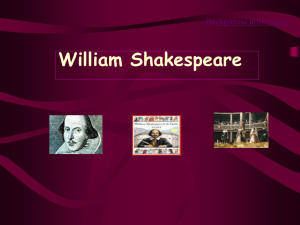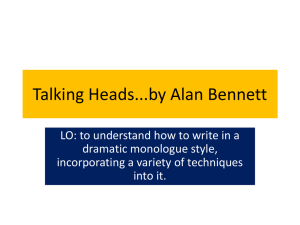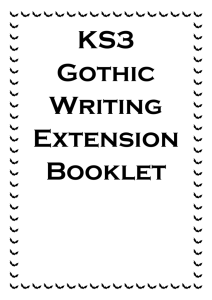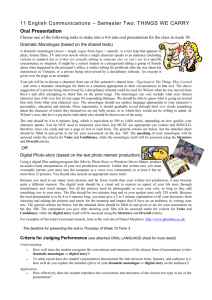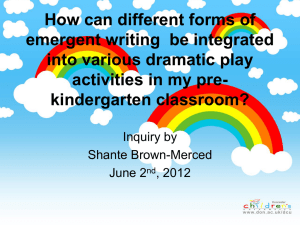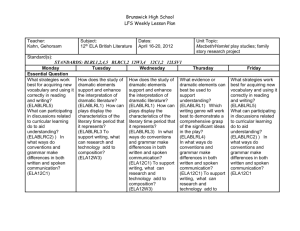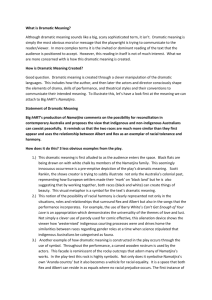English 10 1st Quarter - Unit 2 - Character - Olsen
advertisement
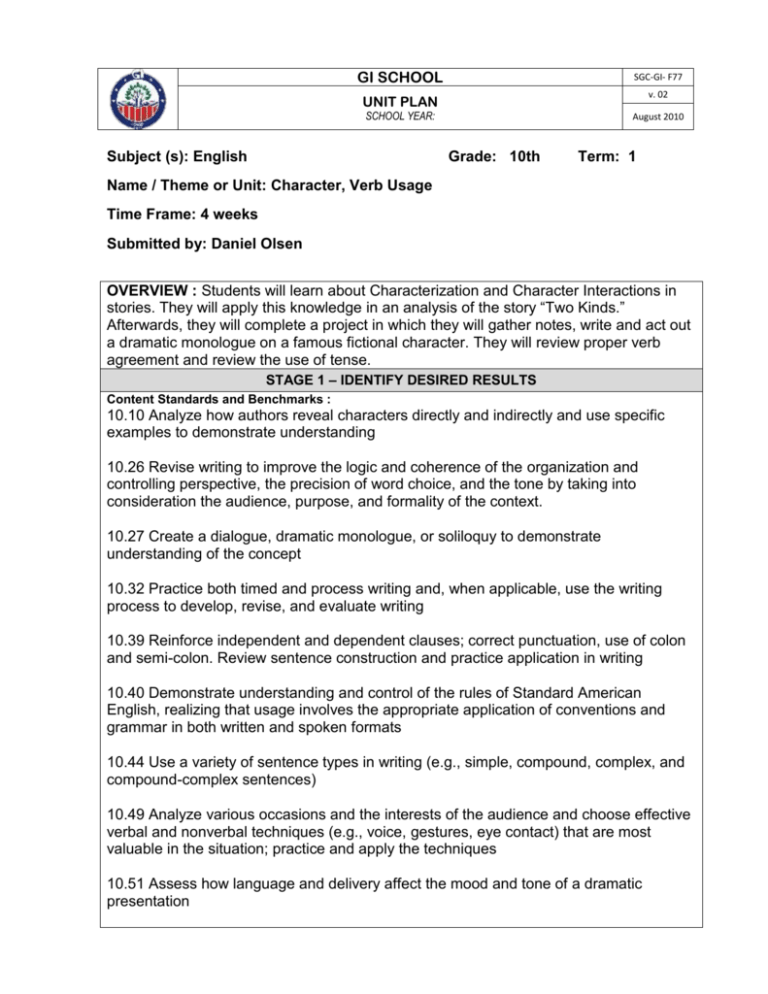
GI SCHOOL SGC-GI- F77 UNIT PLAN v. 02 SCHOOL YEAR: Subject (s): English August 2010 Grade: 10th Term: 1 Name / Theme or Unit: Character, Verb Usage Time Frame: 4 weeks Submitted by: Daniel Olsen OVERVIEW : Students will learn about Characterization and Character Interactions in stories. They will apply this knowledge in an analysis of the story “Two Kinds.” Afterwards, they will complete a project in which they will gather notes, write and act out a dramatic monologue on a famous fictional character. They will review proper verb agreement and review the use of tense. STAGE 1 – IDENTIFY DESIRED RESULTS Content Standards and Benchmarks : 10.10 Analyze how authors reveal characters directly and indirectly and use specific examples to demonstrate understanding 10.26 Revise writing to improve the logic and coherence of the organization and controlling perspective, the precision of word choice, and the tone by taking into consideration the audience, purpose, and formality of the context. 10.27 Create a dialogue, dramatic monologue, or soliloquy to demonstrate understanding of the concept 10.32 Practice both timed and process writing and, when applicable, use the writing process to develop, revise, and evaluate writing 10.39 Reinforce independent and dependent clauses; correct punctuation, use of colon and semi-colon. Review sentence construction and practice application in writing 10.40 Demonstrate understanding and control of the rules of Standard American English, realizing that usage involves the appropriate application of conventions and grammar in both written and spoken formats 10.44 Use a variety of sentence types in writing (e.g., simple, compound, complex, and compound-complex sentences) 10.49 Analyze various occasions and the interests of the audience and choose effective verbal and nonverbal techniques (e.g., voice, gestures, eye contact) that are most valuable in the situation; practice and apply the techniques 10.51 Assess how language and delivery affect the mood and tone of a dramatic presentation 10.54 Create and/or deliver dramatic pieces that employ techniques of a dramatic presentation (annunciation, pronunciation, tone, mood, speed, diction, volume, emotion, audience) 10.58 Record students throughout the year in their oral performance to be able to see progress, determine areas of weakness and strength, and to set goals for improvement Essential questions: 1. What is the difference between direct and indirect characterization? 2. What are the ways in which characters are revealed indirectly? 3. How can a character’s personality be revealed through dramatic presentation? 4. What motivates characters, and how does this make them more like real people? 5. What are the roles that characters play when interacting with each other in stories 6. How are verbs used correctly in a sentence? Expected language: character development, character traits, flat, round, stock, static, and dynamic characters, indirect and direct characterization, actions, narrator, dialogue, description, profile, soliloquy, dramatic monologue, verb agreement, tense, present simple, present perfect, past, future. STAGE 2 – ASSESSMENT EVIDENCE List performance tasks or project, quizzes, graded assignments, prompts, etc. Include the rubrics you use to evaluate the performance tasks. Grammar – Verb Usage Practice Warm up Worksheets Review games Test on Verb Usage Character and “Two Kinds” Character Interactions Quiz Character Motivation Cartoon Assignment Two Kinds Conflict – Motivation chart Characterization Quiz Dramatic Monologue Writing Assignment Dramatic Monologue Presentation Dramatic Monologue Assessment Rubric STAGE 3 – LEARNING ACTIVITIES Consider the type of knowledge (declarative or procedural) and the thinking skills students will use. Grammar – Verb Usage Throughout the 4 weeks of the unit, the first 5-10 minutes of the class students will work on a worksheet relating to sentence structure with help from the teacher and each other. The worksheet will be projected on the board, and will also be available on the wiki for those students who want to download and print them ahead of time. The teacher will share the correct answers each day. At the end of the week, the students will hand in their completed sheets for a mark. A test on verb usage will be given at the end of the unit. Character and analysis of “Two Kinds” Students will view and take notes on a power point on character interactions. Afterwards, students will review their notes and complete the chart at the end of the power point for Tom Benecke, the protagonist of “The Contents of the Dead Man’s Pockets.” The next class, they will write a short quiz assessing their knowledge of the terms . Students will use a picture of a scene involving various characters in different situations. From the picture, they will analyze and write about the motivations of the various characters and their interactions with one another . Students will watch a video of a child prodigy on TV and discuss the issues surrounding child prodigies and parent pressure. Student will share experiences of parent pressure and the problems that conflicting motivations in families can cause. Then they will view the introduction power point on the story “Two Kinds” (in textbook) and preview the vocabulary . When reading the story, the students will revisit their notes and discuss the interactions of the characters and their motivations. Students will read the story and practice fluency in pairs and small groups, before reading again with the whole class and pausing for discussion and explanation. After the story, students will complete the Character Motivation-Conflict chart . Students will then take notes on a second power point on character interactions . With the use of their notes, students will complete a quiz on the terms learned . Dramatic Monologues Next, students will write and deliver a Dramatic Monologue based on a character from popular culture. The character will brainstorm a profile of their character as specified in the assignment hand out , including the various ways the character is revealed in the movie, book, cartoon, TV show, etc. in which they appear. They will then compose a dramatic monologue where the character describes himself or herself and comments on their interactions with other characters and their motivations. Students will submit all preliminary notes as well as a rough and final draft to demonstrate the writing process. They will edit their work with special attention paid to sentence structure. Then, the students will practice, partially memorize, and present the monologue to the class. Attempting to portray their character through body language, speech modulation, and facial expression. The presentations will be recorded for later review. INSTRUCTIONAL MATERIALS AND RESOURCES Holt Language and Literature Text: “Two Kinds” Video clip of Chinese Child prodigy Holt Text Powerpoints Grammar Warm-up Sheets Teacher Created Resources At the end of unit: CURRICULUM COVERAGE: Percentage of planned curriculum that was taught and assessed __%100____ REFLECTIONS: Teachers reflections on ways in which the unit might be improved, polished or enhanced. Student perspectives might be included. Students seemed to respond well to the material. They particularly enjoyed the stories read and scored high on all the assignments and tests given. In order to allow dictionaries in their regular tests, I placed the vocabulary for all of the units in the quarter into a single test that the students prepared for. This worked much better than last year. I also added pronoun-antecedent agreement to the verb section for grammar, as the skills were similar and it was good for the students to practice them simultaneously.

